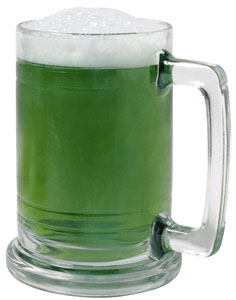
Steve Cole/Getty
Despite its religious origins, since Boston Irish first marked the occasion with a parade in 1737, St. Patrick’s Day, for many, has evolved into a secular, and international, festival of excess. And while there’s nothing wrong with donning some green and enjoying a pint or two of Guinness in honor of the Emerald Isle, before you toss back too much tinted beer and the world goes wobbly through your shamrock glasses, it’s worth reviewing the dangers of overdoing it.
According to data from the Centers for Disease Control and Prevention (CDC), binge drinking—defined as boosting your blood alcohol content (BAC) above the legal limit of .08 by consuming several drinks in a short period of time—is associated with health hazards ranging from alcohol poisoning and unintentional injuries, to increased risk of exposure to sexually transmitted diseases and even neurological damage. Additionally, compared with those who consume alcohol more moderately, binge-drinkers are 14 times more likely to report having driven drunk, according to the CDC.
To understand more about why it’s best to celebrate in moderation, it’s worth viewing two fascinating videos from the American Chemical Society about alcohol’s effects on the body. Sporting a headband with two springy green shamrocks that bounce as she lectures, Dr. Diane Bunce, a chemistry professor at Catholic University of America, walks through the way that our body processes alcohol, beginning her lecture with admonitions about the dangers of excess—including the grim statistic that alcohol abuse is a factor in one third of all car crashes. Bunce explains, among other things, the basic chemical composition of alcohol, how the body processes alcohol, why hard liquors that are darker in color can lead to worse hangovers, and the significance of “proof”—a term that originates with the British navy and means twice the percentage of alcohol in liquor (so 90 proof gin has 45% alcohol content).
Of course, in addition to more deadly consequences of excess alcohol consumption—including, as Bunce points out, the horrifying possibility of suffocation as a result of alcohol poisoning limiting muscle function critical to respiration—the most commonly experienced adverse effect of binge drinking is the hangover. In a second video, Bunce explains what causes hangovers, including headache due to lowered blood sugar or an allergic reaction to congeners in alcohol, nausea resulting from the excess production of stomach acid in response to alcohol, and dehydration due to alcohol’s interference in the production of a hormone that cues the kidneys to preserve water.
Armed with a few sobering facts about how alcohol impacts the body—as well as a reminder about the discomfort of a Thursday morning hangover—please celebrate responsibly. Happy St. Patrick’s Day!

